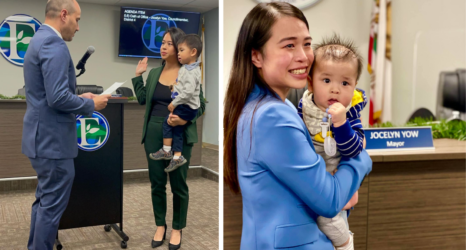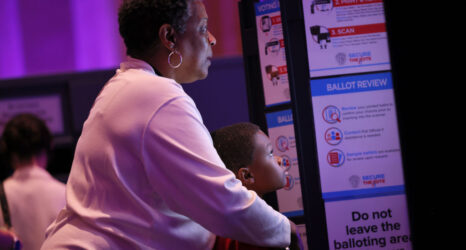With the 2018 election now in full swing, the Ms. Blog is excited to bring you content presented in conjunction with Gender Watch 2018, a project of the Barbara Lee Family Foundation and the Center for American Women and Politics. They’ll be tracking, analyzing and illuminating gender dynamics during election season—so check back with us regularly!
Given the intense focus on gender in the 2018 midterms—including ongoing coverage of women receiving payoffs to bury affairs with President Trump, the growing #MeToo movement, a few high-profile defections from the GOP and the spate of female candidates making explicit, gender-based appeals in their campaigns—the question many people want answered is: how is all of this talk of gender going to affect female voters in November?
Some analysts suspect that the focus on gender may unify women behind Democratic candidates, and particularly female Democratic candidates, ushering in a major Democratic upset. This narrative is reinforced by perceptions of a widening gender gap—narratives echoed by reporting around recent polling data.
Two July polls of registered voters conducted by Quinnipiac University suggested that women strongly favor Democratic House candidates. According to one, if the election for the U.S. House of Representatives were being held today, 58 percent of women would vote for the Democratic candidate compared to 42 percent of men—a 16-point gender gap. Another poll later in the month provided a largely similar result: 57 percent of women said they would vote for the Democratic candidate compared to 44 percent of men—a 13-point gender gap. A May 2016 national Washington Post/ABC News poll asking the same question yielded an 11-point gender gap in Democratic support: 50 percent of women and 39 percent of men reported their intention to vote for a Democrat in their congressional district.
These figures seem to reinforce narratives that women voters will lead the Democratic wave of success come November. But they don’t necessarily point to a growing “chasm” between men and women. The way this data is reported—simply comparing all men to all women regardless of party—is misleading. There are several factors that cut across gender and offer a lot of explanatory power when it comes to political behavior or vote choice—and partisanship is the most prominent among them.
I asked the pollsters at Quinnipiac University to provide more explicit comparisons between men and women in both parties using data from their July polls—and the data show that if the election for the U.S. House of Representatives were being held today, both men and women would overwhelmingly vote for members of their own party.
In the first, 93 percent of Republican women reported that they intend to vote for the Republican candidate. In the second, 88 percent of Republican women did. In both, 93 percent of Republican men claimed the same intention. These figures suggest few differences between Republican men and women in November, contrary to the idea of an ever-widening gulf between men and women—and fit with established accounts of party loyalty among GOP women.
In research conducted with my colleague Dr. Tiffany Barnes, we find that the gulf between the political preferences of Democrats and Republicans is wide and much larger than gender differences within the parties. Republican women, on average, don’t hold political attitudes that are identical to Republican men—but differences are quite small when compared to gap between Republican women and the men and women of the Democratic party.
Beyond this, our research suggests that many women, particularly white women, often endorse sexist attitudes and often believe gender-based discrimination in the U.S. is not widespread. These beliefs predicted voting for Donald Trump in 2016, and they are likely bolstering continued support for Republican candidates in the current political climate. Republican women who hold sexist beliefs are unlikely to be deterred by sexism in campaigns; it doesn’t resonate as a threat in the way that it does for many Democratic women.
Another misleading narrative in recent coverage of the gender gap is that Republican women, demobilized by a sense of growing dissatisfaction with their party but unwilling to cross party lines and vote for Democratic candidates, will stay home on Election Day. Analysts predicted this same outcome in 2016, but turnout among women was relatively stable overall—63.3 percent of women turned out that year, compared to 63.7 percent in 2012, and turnout actually increased among white women, from 65.6 percent to 66.8.
Quinnipiac’s first survey asked registered voters about their motivation to vote in the midterms—and zero percent of the Republican women reported lower motivation to vote in 2018 than in prior elections. Sixty-two percent said they are about as motivated as they typically are, and 38 percent reported being more motivated than usual to vote. These figures don’t differ much from Republican men. (The question was not asked in the second.)
The comparison of responses given by Republican women and Democratic women, however, points to an asymmetry in mobilization among women: While Republican women don’t show any evidence of demobilization, Democratic women report significantly higher levels of motivation to vote compared to past elections.
Sixty-one percent of Democratic women, compared to 38 percent of Republican women, report that they are more motivated to vote than usual. This 23-point mobilization gap among Republican and Democratic women suggests that women are responding to candidates running in midterm elections and the current political climate in different ways. Such a finding is consistent with the idea that women voters are a diverse group and tend not to vote or respond to political events in a uniform fashion.
Even now, when issues of gender, power, fairness and equity are at the forefront of our political conversations, women don’t all agree on the best way forward. Unfortunately, much of the mainstream media coverage of women voters assumes they should—and anticipates that women voters will eventually band together around a set of common interests. Why isn’t the same diversity of political belief we allow for men accepted for women?
When we try to force all women voters into the same box, we lose perspective on the meaning and implications of gender in electoral politics. Looking at the gender gap among partisans and not just between men and women, regardless of party, helps us regain some much-needed perspective.
To say that we are experiencing a historic gender gap is an overstatement. Gender will influence the midterms elections in a variety of ways, but it’s a mistake to continue to overlook the dominant effect of partisanship on vote intentions.
Ultimately, these data, presented this way and in the context of the 2016 presidential race, provide a cautionary tale: It’s a mistake to conflate the growing salience of gender in politics with increased political unity among women.





